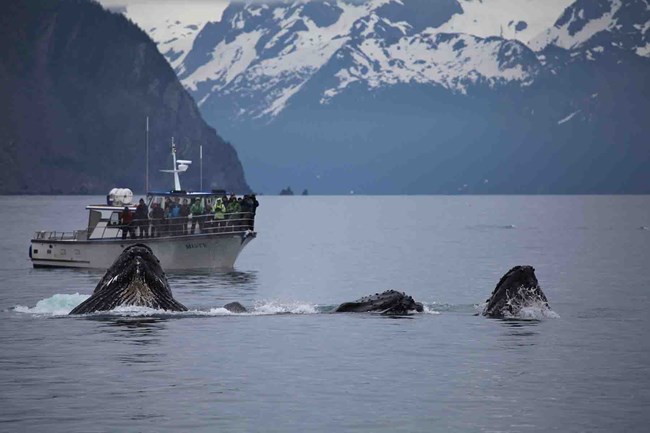Last updated: October 7, 2019
Article
Actions that Reduce Ship-Whale Collisions

Lethal collisions with large ships (ship strikes) are a recurring and common threat to whale populations across the globe. To reduce the risk of a ship striking a whale, most efforts have focused on modifying shipping lanes and reducing the speed at which ships travel, but these are fairly narrow approaches and more can be done. In this study, we identified additional actions that could be taken and tested their effectiveness by using models of whale behavior and ship simulations. Some options we identify for avoiding whales include (1) training Lookouts to refine their search efforts, (2) standardize protocols for rapid communication of sighings so action can be taken more quickly, and (3) identify specific areas where whales are most common for planned speed reduction.
Active Whale Avoidance by Large Ships: Components and Constraints of a Complementary Approach to Reducing Ship Strike Risk
Abstract
The recurrence of lethal ship-whale collisions (ship strikes) has prompted management entities across the globe to seek effective ways for reducing collision risk. Here we describe active whale avoidance defined as a mariner making operational decisions to reduce the chance of a collision with a sighted whale. We generated a conceptual model of active whale avoidance and, as a proof of concept, apply data to the model based on observations of humpback whales surfacing in the proximity of large cruise ships, and simulations run in a full-mission bridge simulator and commonly used pilotage software. Application of the model demonstrated that (1) the opportunities for detecting a surfacing whale are often limited and temporary, (2) the cumulative probability of detecting one of the available ‘cues’ of whale’s presence (and direction of travel) decreases with increased ship-to-whale distances, and (3) following detection time delays occur related to avoidance operations. These delays were attributed to the mariner evaluating competing risks (e.g., risk of whale collision vs. risk to human life, the ship, or other aspects of the marine environment), deciding upon an appropriate avoidance action, and achieving a new operational state by the ship once a maneuver is commanded. We thus identify several options for enhancing whale avoidance including training Lookouts to focus search efforts on a ‘Cone of Concern,’ defined here as the area forward of the ship where whales are at risk of collision based on the whale and ship’s transit/swimming speed and direction of travel. Standardizing protocols for rapid communication of relevant sighting information among bridge team members can also increase avoidance by sharing information on the whale that is of sufficient quality to be actionable. We also found that, for marine pilots in Alaska, a slight change in course tends to be preferable to slowing the ship in response to a single sighted whale, owing, in part, to the substantial distance required to achieve an effective speed reduction in a safe manner. However, planned, temporary speed reductions in known areas of whale aggregations, particularly in navigationally constrained areas, provide a greater range of options for avoidance, highlighting the value of real-time sharing of whale sighting data by mariners. Development and application of these concepts in modules in full mission ship simulators can be of significant value in training inexperienced mariners by replicating situations and effective avoidance maneuvers (reducing the need to ‘learn on the water’), helping regulators understand the feasibility of avoidance options, and, identifying priority research threads. We conclude that application of active whale avoidance techniques by large ships is a feasible yet underdeveloped tool for reducing collision risk globally, and highlight the value of local collaboration and integration of ideas across disciplines to finding solutions to mutually desired conservation outcomes.
Gende, S. M., L. Vose, J. Baken, C. M. Gabriele, R. Preston, and A. N. Hendrix. 2019. Active whale avoidance by large ships: Components and constraints of a complementary approach to reducing ship strike risk. Frontiers in Marine Science https://doi.org/10.3389/fmars.2019.00592
